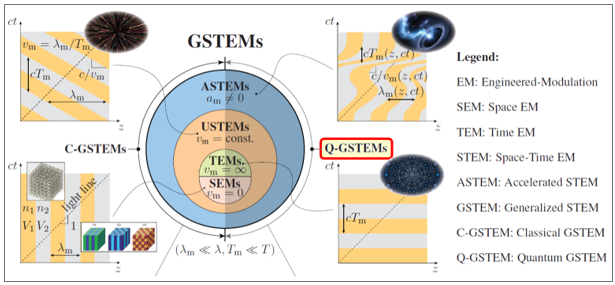Quantum Scattering on Space-Time Interfaces
Leuven | More than two weeks ago
Take metamaterials to their 4th generation, beyond space and time.
Recently, there has been an explosion of interest for time-modulated and space-time-modulated metamaterials, which are electronic and electromagnetic structures formed by the traveling-wave modulation of some parameter (e.g., refractive index or electronic potential) of a host medium (e.g., piezoelectric or semiconductor crystal) [1]. Such metamaterials can manipulate waves in unprecedented fashions and have already led to a host of applications across the entire electromagnetic spectrum.
We have termed these metamaterials Generalized Space-Time Engineered-Modulation (GSTEM) metamaterials, or GSTEMs for short. As illustrated in the figure, GSTEMs include purely spatial (SEM), purely temporal (TEM), uniform-velocity spatio-temporal (USTEM) and accelerated (ASTEM) structures. So far, the vast majority of GSTEMs have been classical, i.e., C-GSTEMs (left sector of the diagram in the figure, and Quantum GSTEMs, or Q-GSTEMs (right sector of this diagram) have been hardly explored [2].

This PhD project will resolve some canonical (TEM and USTEM) Q-GSTEM problems, specifically the scattering of electrons at GSTEM interfaces between semiconductors with different potentials. The core of the modeling work will consist in solving the Dirac equation with novel GSTEM boundary conditions for such structures and analyzing the related key physical effects, particularly novel energy-momentum transitions and scattering magnitudes of different types. In addition, it will benchmark these analytical results with numerical codes available in the group.
In the frame of the PhD, an important effort will be spent on the experimental demonstration of the concepts developed. In particular, applicability to photonic, phononic and electronic domains will be assessed.
This work will represent a contribution to this new field of quantum electronics, which is expected to result into new devices for a diversity of quantum processing applications (computing, sensing, metrology, etc.).
[1] C. Caloz, Z.-L. Deck-Léger, A. Bahrami, C. Vicente, and Z. Li, “Generalized space-time engineered modulation (GSTEM) metamaterials: a global and extended perspective,” IEEE Antennas Propag. Mag., pp. 1–12, Dec. 2022.
[2] C. Caloz, A. Bahrami, Z.-L. Deck-Léger, Z. Li, and F. Ok, “Classical and quantum generalized space-time engineered-modulation (GSTEM) metamaterials,” in Metamaterials’2023, Int. Congr. Art. Mat. Nov. Wave. Phenom., Crete, Greece, Sep. 2023.
Required background: Physics, nano-engineering
Type of work: 50% modeling/simulations, 40% experimental, 10% literature
Supervisor: Christophe Caloz
Co-supervisor: Xavier Rottenberg
Daily advisor: Pol Van Dorpe
The reference code for this position is 2024-139. Mention this reference code on your application form.
